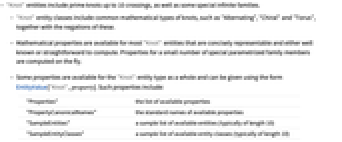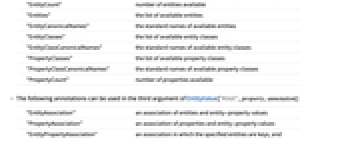-
See Also
- Entity Types
- Graph
- FiniteGroup
- Lattice
- LatticeSystem
- IntegerSequence
-
- Interpreter Types
- Knot
- ComputedKnot
- Related Guides
-
-
See Also
- Entity Types
- Graph
- FiniteGroup
- Lattice
- LatticeSystem
- IntegerSequence
-
- Interpreter Types
- Knot
- ComputedKnot
- Related Guides
-
See Also
![]() [prop]
[prop]
gives the value of a specified property.
![]() [{propi,…}]
[{propi,…}]
gives the value of a list of properties.
![]() [prop,{qualivali,…}]
[prop,{qualivali,…}]
gives the value of a specified property modified by qualifier rules quali->vali.
EntityClass["Knot",{propispeci,…}]
represents a class of entities with values of propi defined by speci.
Sample Entities
-









 …
…
Sample Entity Classes
-









 …
…
Properties




-
AlexanderBriggsNotation Alexander‐Briggs notation AlexanderPolynomial Alexander polynomial AlternateNames alternate names Alternating alternating Amphichiral amphichiral ArfInvariant Arf invariant BLMHoPolynomial BLM/Ho polynomial BoundaryMeshRegion boundary mesh representation BracketPolynomial bracket polynomial BraidDiagram braid diagram BraidIndex braid index BraidWord braid word BridgeIndex bridge index Chiral chiral Classes classes ColoringNumberSet coloring number set Composite composite ConcordanceOrder concordance order ConwayNotation Conway notation ConwayPolynomial Conway polynomial CrossingNumber crossing number DegreeThreeVassiliev degree‐3 Vassiliev invariant DegreeTwoVassiliev degree‐2 Vassiliev invariant Determinant determinant DowkerNotation Dowker notation EntityClasses entity classes EntityTypeList entity type list Genus genus of complement Graphic graphic HOMFLYPolynomial HOMFLY polynomial Hyperbolic hyperbolic HyperbolicVolume hyperbolic volume of complement Information hyperlink Invertible invertible JonesPolynomial Jones polynomial KauffmanPolynomial Kauffman polynomial KnotDiagram knot diagram MeshRegion mesh representation NakanishiIndex Nakanishi index Name name Nonalternating nonalternating Nonhyperbolic nonhyperbolic Noninvertible noninvertible Nonsatellite nonsatellite Nontorus nontorus OzsvathSzaboTau Ozsváth‐Szabó τ‐invariant Polyhedron polyhedron Prime prime Region region Satellite satellite SeifertMatrix Seifert matrix Signature signature SmoothFourGenus smooth 4‐genus SpaceCurve space curve StickNumber stick number SuperbridgeIndex superbridge index ThurstonBennequin Thurston‐Bennequin number TopologicalFourGenus topological 4‐genus Torus torus UnknottingNumber unknotting number
Details


- "Knot" entities include prime knots up to 10 crossings, as well as some special infinite families.
- "Knot" entity classes include common mathematical types of knots, such as "Alternating", "Chiral" and "Torus", together with the negations of these.
- Mathematical properties are available for most "Knot" entities that are concisely representable and either well known or straightforward to compute. Properties for a small number of special parametrized family members are computed on the fly.
- Some properties are available for the "Knot" entity type as a whole and can be given using the form EntityValue["Knot",property]. Such properties include:
-
"Properties" the list of available properties "PropertyCanonicalNames" the standard names of available properties "SampleEntities" a sample list of available entities (typically of length 10) "SampleEntityClasses" a sample list of available entity classes (typically of length 10) "EntityCount" number of entities available "Entities" the list of available entities "EntityCanonicalNames" the standard names of available entities "EntityClasses" the list of available entity classes "EntityClassCanonicalNames" the standard names of available entity classes "PropertyClasses" the list of available property classes "PropertyClassCanonicalNames" the standard names of available property classes "PropertyCount" number of properties available - The following annotations can be used in the third argument of EntityValue["Knot",property,annotation]:
-
"EntityAssociation" an association of entities and entity-property values "PropertyAssociation" an association of properties and entity-property values "EntityPropertyAssociation" an association in which the specified entities are keys, and values are a nested association of properties and entity-property values "PropertyEntityAssociation" an association in which the specified properties are keys, and values are a nested association of entities and entity-property values "Dataset" a dataset in which the specified entities are keys, and values are an association of property names and entity-property values - The following annotations can be used in the second argument of EntityValue[property,annotation]:
-
"Qualifiers" the list of possible qualifiers for the property "QualifierValues" the list of possible values that can be given to each qualifier "DefaultQualifierValues" the list of default values for the property's qualifiers "Description" a brief textual description of the property - A qualifier value of Automatic indicates that an applicable format of values can be used.
Examples
open all close allBasic Examples (4)
Scope (5)
Qualifiers (5)
Give the available qualifiers for the "AlexanderBriggsNotation" property:
Give the available qualifiers and values for the "AlexanderBriggsNotation" property:
Give a computable form for the Alexander–Briggs notation of the figure eight knot:
Give a typeset form for the Alexander–Briggs notation of the figure eight knot:
Give the available qualifiers for the "BraidDiagram" property:
Give the available qualifiers and values for the "BraidDiagram" property:
Give a 2D graphic for the Solomon's seal knot:
Give the available qualifiers for the "BraidWord" property:
Give the available qualifiers and values for the "BraidWord" property:
Give a computable form for the braid word of the figure eight knot:
Give a typeset form for the braid word of the figure eight knot:
Give the available qualifiers for the "DowkerNotation" property:
Give the available qualifiers and values for the "DowkerNotation" property:
Give a computable form for the Dowker notation of the figure eight knot:
Give a typeset form for the Dowker notation of the figure eight knot:
Give the available qualifiers for the "Graphic" property:
Give a computable form for the Dowker notation of the figure eight knot:
See Also
Entity Types: Graph FiniteGroup Lattice LatticeSystem IntegerSequence
Interpreter Types: Knot ComputedKnot
Related Guides
History
Introduced in 2019 (12.0) | Updated in 2022 (13.1)